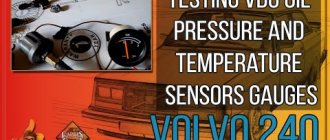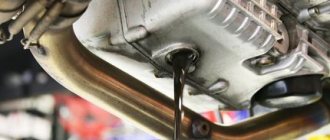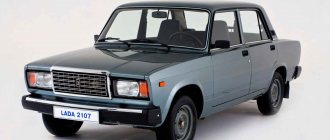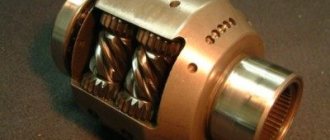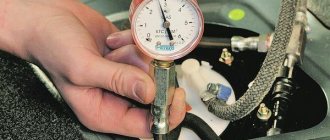Since the invention of the first internal combustion engine, engineers have had a very important goal - to extract maximum power from a specific volume of the power unit. Trying to solve this problem, designers conducted experiments with the number and layout of combustion chambers.
At various times, production car models used both small single-cylinder internal combustion engines and huge units with 16 cylinders. On different models, the combustion chambers are located and numbered differently, and this information will be very useful for a novice car enthusiast.
How are the cylinders located in engines?
There are different engine models - these include vintage one- and two-cylinder internal combustion engines, traditional in-line four- and six-cylinder models.
Related article: Signs, causes and consequences of car engine overheating
Larger units had V-shaped blocks - such units could have eight or more combustion chambers.
Row arrangement
With an in-line arrangement in the block, the cylinders are arranged in one row. In this configuration, there are two, three, four, five and even six-cylinder engines.
Two- and three-cylinder internal combustion engines are now installed on modern cars less often, although their popularity is slowly gaining momentum.
This was facilitated by smart fuel mixture preparation systems and turbines - for example, a turbocharged version of the two-cylinder internal combustion engine of the Fiat 500 hatchback. The three-cylinder in-line engine can be found on the Daewoo Matiz and many others.
As for the in-line “four”, such blocks are installed in most engines for passenger cars - the volumes of such engines start from 1 liter, and the largest in-line internal combustion engine is 2.4 liters. and more.
In-line five-cylinder engines began appearing in mass-produced cars in the 1970s. Among the first are Mercedes diesel models - they were installed in 1974 on the W123 model.
And already in 1976 they built a five-cylinder engine from Audi. Starting from the late 80s, the inline five no longer surprised anyone and was successfully installed on a variety of cars from Fiat, Volvo and other auto brands.
Common motors and cylinder operating order
As an example, to begin with, let's consider 4-cylinder in-line ZMZ engines and similar units. For example, the operating order of the ZMZ-402 cylinders is: 1-2-4-3, while the ZMZ-406 is: 1-3-4-2. The Audi 80 B3 engine has a 1-3-4-2 operating order. The alternation of cycles occurs every 1800.
As you can see, the operating order of a single-row 4-cylinder engine can be 1-3-4-2 (typical for VAZ) or 1-2-4-3 (in the case of GAZ engines).
If we talk about a 6-cylinder in-line engine, then the sequence is: 1-5-3-6-2-4, and the interval between ignition is 1200. In turn, in relation to an 8-cylinder V-shaped engine: 1-5-4 -8-6-3-7-2, the interval between ignitions will already be 900.
Let’s also add that the operating order of the 12-cylinder W-shaped engine is as follows: 1-3-5-2-4-6 for the left cylinder heads, while for the right ones 7-9-11-8-10-12. To put it simply, in such engines the order of operation of the cylinders is divided into two types (similar to in-line “fours”): 1-3-4-2 and 1-2-4-3.
We also recommend reading the article about what a turbocharger is in an internal combustion engine. From this article you will learn about compressors of this type, their purpose, design, operating principles, as well as the advantages and disadvantages of turbo engines.
The firing order of the V-6 engine is also different. There are versions where the order is: 1-6-3-5-2-4 or 1-4-2-5-3-6. At the same time, the order of operation of an in-line engine with 6 cylinders and ignition of the mixture is: 1-5-3-6-2-4. It is also noteworthy that the Japanese Mitsubishi MIVEC engines, 6G72, have a cylinder operating order of 1-2-3-4-5 -6.
- Please note, as mentioned above, six-cylinder V-shaped engines are the most problematic in terms of balancing, that is, they are quite heavily vibration-loaded.
To reduce vibrations and improve balancing during engine operation, the design of the internal combustion engine includes devices, solutions and mechanisms for balancing the moments of inertia of the pistons, the upper parts of the connecting rods, etc. To put it simply, such a motor contains counterweights, flywheels, balance shafts, pulleys and other elements.
Also, in order to reduce vibration levels, manufacturers use different operating orders for the cylinders. As an example, on an 8-cylinder internal combustion engine, the alternation of strokes can be 1-5-4-2-6-3-7-8 or the cylinder operating order 1-5-4-8-6-3-7-2 ( BMW M60), 1-3-7-2-6-5-4-8, etc. It turns out, as is the case with other types of power units, 8-cylinder engines also do not have a clearly defined order of operation of the cylinders.
Numbering of cylinders in different types of internal combustion engines
As for the standards for numbering combustion chambers, there are none. The way they are numbered in the internal combustion engine is influenced by the following factors:
- Type of drive;
- ICE type, block layout;
- Transverse or longitudinal arrangement of the unit under the hood;
- Side of rotation.
On standard front-wheel drive cars with a transversely mounted engine, the numbering begins on the timing side. So, near the timing belt there is the first cylinder and then all the others. The latter is located near the checkpoint.
Examples
In multi-cylinder V-twin engines, the first cylinder is located in the bank on the driver's side.
In American-made engines, the combustion chambers and their numbering may differ and defy logic.
So, for in-line fours and sixes, the first cylinder may be near the radiator, while on all other models the numbering begins towards the interior. If the numbering is reversed, then the cylinder closest to the passenger compartment is considered first.
Note: How to remove a hernia on a car wheel and why it is dangerous
The French are very original and use two methods of numbering the combustion chambers of internal combustion engines.
- On inline fours, the numbering starts from the flywheel.
- If it is a V-shaped six, then the row closest to the radiator is the first three cylinders, and the row closer to the passenger compartment is the last three.
—>Auto parts and service stations —>
Ordinary car enthusiasts do not necessarily need to know the operating order of the engine cylinders. Well, it works and works. Yes, it’s hard to disagree with this. It is not necessary until you want to set the ignition yourself or start adjusting the valve clearances.
It will not be superfluous to know about the operating order of the car engine cylinders when you need to connect high-voltage wires to spark plugs, or high-pressure pipelines for a diesel engine. What if you decide to repair the cylinder head?
Well, you must admit, it would be funny to go to a car service center in order to correctly install the explosive wires. And how to go? If the engine troits.
What does the order of operation of the engine cylinders mean?
The sequence with which strokes of the same name alternate in different cylinders is called the order of operation of the cylinders.
What determines the order of operation of the cylinders? There are several factors, namely:
— engine cylinder arrangement: single-row or V-shaped; — number of cylinders; — camshaft design; - type and design of the crankshaft.
Engine duty cycle
The engine operating cycle consists of gas distribution phases. The sequence of these phases should be evenly distributed according to the force acting on the crankshaft. It is in this case that the engine runs smoothly.
A prerequisite is that the cylinders operating in series should not be located next to each other. For this purpose, engine manufacturers develop diagrams for the operating order of engine cylinders. But, in all schemes, the order of operation of the cylinders begins with the main cylinder No. 1.
The gas distribution phase is the moment at which the opening begins and the closing of the valves ends. The valve timing is measured in degrees of crankshaft rotation relative to the top and bottom dead centers (TDC and BDC).
During the operating cycle, a mixture of fuel and air ignites in the cylinder. The interval between ignitions in the cylinder has a direct impact on the uniformity of engine operation. The engine runs as smoothly as possible with the shortest ignition interval.
This cycle directly depends on the number of cylinders. The greater the number of cylinders, the shorter the ignition interval will be.
The order of operation of the cylinders in different engines:
For engines of the same type, but of different modifications, the operation of the cylinders may differ. For example, the ZMZ engine. The cylinder firing order of the 402 engine is 1-2-4-3, while the cylinder firing order of the 406 engine is 1-3-4-2.
If we delve deeper into the theory of engine operation, but so as not to get confused, we will see the following. The full operating cycle of a 4-stroke engine takes two revolutions of the crankshaft. In degrees this is equal to 720. For a 2-stroke engine it is 3600.
The shaft elbows are shifted to a certain angle so that the shaft is under constant force from the pistons. This angle directly depends on the number of cylinders and engine stroke.
— The operating order of a 6-cylinder in-line engine is 1-5-3-6-2-4 (the ignition interval is 1200).
— The operating order of the 8-cylinder V-engine is 1-5-4-8-6-3-7-2 (ignition interval 900).
— There is, for example, the order of operation of a 12-cylinder W-shaped engine: 1-3-5-2-4-6 are the left cylinder heads, and the right ones: 7-9-11-8-10-12
In order for you to understand this whole order of numbers, let's look at an example. The 8 cylinder ZIL engine has the following cylinder operating order: 1-5-4-2-6-3-7-8. The cranks are located at an angle of 900.
That is, if a working cycle occurs in cylinder 1, then through 90 degrees of crankshaft rotation, the working cycle occurs in cylinder 5, and sequentially 4-2-6-3-7-8. In our case, one crankshaft rotation is equal to 4 working strokes. The natural conclusion is that an 8-cylinder engine runs smoother and more evenly than a 6-cylinder engine.
Most likely, you will not need in-depth knowledge of the order of operation of the cylinders of your car's engine. But it is necessary to have a general idea about this. And if you decide to repair, for example, the cylinder head, then this knowledge will not be superfluous.
Source
Preparing the car
The machine being manipulated is placed on a flat surface. The driver's cabin reclines and locks. The upper part of the gas distribution mechanism is dismantled and the pump is turned off.
KamAZ 43118:
Devices:
- Keys: open-end for 13, ring for 14;
- Screwdrivers;
- Steel rod;
- Set of measuring plates.
Fixing the main chamber piston at the top
- Check the fixation force of the camera heads;
- Move the flywheel stop device down;
- Remove the flywheel housing protection plate;
- Insert the steel rod into the hole in the flywheel, turn clockwise until the product stops. Position – beginning of mixture injection (cylinder one).
Flywheel retainer, KamAZ engine:
Setting gaps
- Rotate the flywheel (2 holes – 60°, each 30°);
- Adjust the spacing of the first pair of cameras (1st and 5th). Using a 14 ring wrench, loosen the nuts
- adjusting screws. Use the 0.3 plate to adjust the intake valve, and the 0.4 plate to adjust the exhaust valve.
- Fix the nut, force 33-41 Nm.
- Adjust the spacing in chambers one through eight.
Setting up KamAZ 740, 6520, 5511 valves and other modifications:
- 180 degrees – 4th, 2nd;
- 180 degrees – 6th, 3rd;
- 180 degrees – 7th, 8th.
Adjusting clearances KamAZ:
How to profitably exchange a used car
- Legal support of the transaction: the client enters into a notarized agreement and, if necessary, can use the credit services of the car dealership’s partner bank;
- Efficiency of the service: the client does not need to look for buyers for his vehicle; he does not need to settle issues with the traffic police or the bank. The listed functions are the task of the auto center.
Read here! Engine sump
Thus, with minimal documents, it is possible to buy an improved car within one to three days. The used car exchange service makes it possible to regularly change the owner’s vehicle fleet by purchasing its best models.
4-cylinder boxer layout
In such a motor, the “pots” are placed in two rows at 180 degrees. This allows the power unit to be balanced and the center of gravity to be lower, and the crankshaft receives less load. Thanks to this, a motor of a similar layout, with the same weight, produces more power and speed.
The cylinders in these internal combustion engines operate according to an excellent scheme: the main one is 1-3-2-4, and the alternative is 1-4-2-3.
Here the pistons reach the so-called "top dead center", often abbreviated to TDC, on both sides simultaneously.
Interesting: there are cars with V-shaped units with 4 cylinders, but such examples on the market are relatively rare, the bulk are in-line and opposed.
Definition
Cylinder firing order is the sequence in which the cylinders fire alternately. Otherwise, we can call it a sequence of alternating expansion cycles. Factors influencing it: the number of cylinders, the nature of their arrangement, the design of the engine (in particular, the camshaft and crankshaft), as well as the interval between flashes. To be more precise, it is influenced by the location of the cylinders, crank journals and camshaft cams. The smooth operation of the engine, it is worth noting, depends, among other factors, on the sequence of strokes.
Tact
The movement of the piston inside the engine cylinders is called the duty cycle. The cycle consists of valve timing phases, which can be used to determine the moment of opening and closing of the valves. In a four-stroke vehicle, the full cycle occurs after turning the crankshaft by 720 degrees, in a two-stroke vehicle - by 360.
To provide the shaft with constant force during the power stroke in the engine cylinders, the knees of the unit are located at a certain angle relative to each other. The angle is affected by the number of cylinders, the type of installation and the location of the cylinders.
How to determine the operating order of internal combustion engine cylinders depending on the strokes.
Engine Tactics
The operation of engine cylinders consists of the following stages:
- Intake - the piston moves to bottom dead center, and the combustion chamber is filled with the air-fuel mixture through the intake valve. The exhaust valve is closed.
- Compression - both valves are closed, the piston moves to top dead center, compressing the fuel composition. Due to compression, the temperature in the chamber increases significantly, and the pressure in the engine cylinder also increases. An important parameter that affects the efficiency of a car is the compression ratio. The indicator means the ratio of the complete filling of the cartridges and the volume of the combustion chamber. For cars with a high octane number, high-octane fuel is required.
- The working stroke is when the valve is in the closed position, the mixture is ignited by the spark plug. Under the influence of pressure in the cylinder of the car engine during fuel combustion, the piston goes down, rotating the crankshaft. For efficient performance, it is necessary that the fuel burns completely before the piston reaches BDC. This is ensured by setting the ignition timing. In modern cars, adjustment is carried out by a built-in electronic unit. Older models are equipped with a mechanical regulator.
- Exhaust - the power stroke ends with the exhaust of exhaust gases from the engine cylinders. At this stage, an important process occurs - purging the engine cylinders. Purging of the engine cylinders is ensured by the simultaneous opening of the intake and exhaust valves. After the piston reaches TDC, the intake stroke begins.
